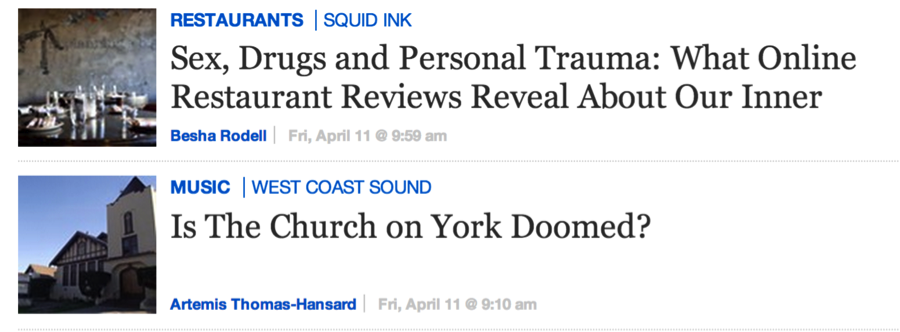
For a journalism website to be successful, it needs to be sustainable. Readers need new reasons to keep clicking, reading and sharing every time they return to the site. Cute kitties just aren't going to cut it -- at least, not cute kitties alone. Journalism websites should offer a variety of material and styles of presentation, mixing hard-hitting with easy-to-digest news.
The lighter content doesn't need to be pure fluff, however. There are other ways to seem entertaining and attractive, like clever titles, intriguing teasers, and eye-catching photos. Sometimes these elements are called "click bait," with no small measure of disdain. The negative connotation stems from the idea that websites will do anything to get readers to just click - even if the content isn't newsworthy, or even relevant to the "click bait."
But click bait can be honest and accurate while still compelling, especially if it hits a nerve on a controversial topic, or asks a surprising question.
The LA Weekly does a fairly good job. Its headlines are short and to-the-point, often posing a question that the reader can only find the answer to by clicking the article.

Let's look at the hard news items first. "Tupac & Biggie: Case Closed?" asks one headline. The reader wonders what is new in the Tupac and Biggie case. "Why Muzeo Canceled Its Graffiti Show," says another. The reader is compelled to ask: Well, what was the reason? By putting the issue into a headline, we are lead to think the reason is mysterious and compelling. The last example from the top headline is "Crystabel Funes Fighting to See Her Child." The reader forms a question: Why is Crystabel fighting to see her child? And why should any woman need to fight to see her child?


Even lighter topics, like food and music, are successfully teased with intriguing headlines. "Sex, Drugs and Personal Trauma: What Online Restaurant Reviews Reveal About Our Inner Selves" reads the headline of a food blog post. The post is about a new study that analyzed word choice for online restaurant reviews to understand the psychology of the reviewers. It doesn't sound too exciting when you put it that way. The headline the LA Weekly chose is still fair and accurate, while much more compelling that saying "New Study of Restaurant Reviews."
Another food headline also puts a compelling spin on a simple topic. "3 Tools That La Casita Mexicana Chefs Can't Live Without," it reads. Really, they can't live without these tools? Clearly, it's hyperbole, but intriguing nevertheless. Readers are much more interested in clicking than if the headline were simply, "3 Tools Chefs Recommend."
A music headline, goes back to the question formula, asking, "Is The Church on York Doomed?" The word "doomed" is vague enough to mean a number of things - yet gives a sinister edge that makes the reader curious.
Of course, the nature of Clickbait is evolving. What works today may not work tomorrow if readers get bored with a certain formula. It's worthwhile for websites to experiment - but never to compromise quality and integrity.
Send Daina a note at dainabeth@gmail.com, and follow her on Twitter @dainabethcita.